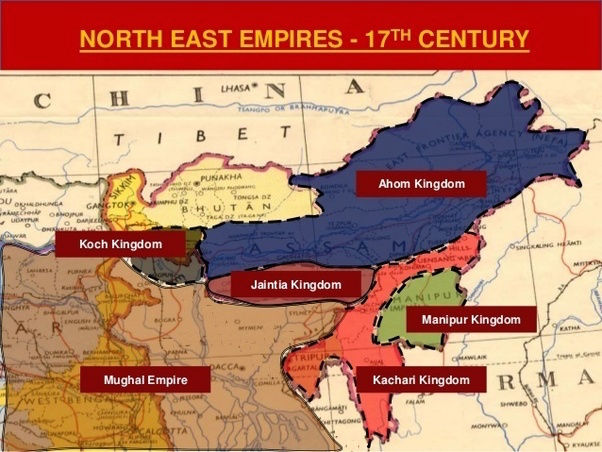
Now known as the Indian state of Assam there has existed in North East India from 1228 to1826 C.E (600 years) the highly prosperous civilisation known as [Ahom Kingdom](https://en.wikipedia.org/wiki/Ahom_kingdom) .
Though peace loving, the Ahom were no pushovers. To protect their civilisation the Ahom had a very strong military tradition.
A soldier is someone who fights in an army.
A Warrior I would describe as a great and noble soldier.

One such great Ahom warrior was General Lachit Borfukan, (1622 -1672), who effectively drove the powerful but impertinent and adventurous Moghul army and rulers out of Assam for ever.
So great is Lachit Borfukan considered by Military historians and experts, that the Indian Armed forces each year awards the best graduating cadet at the prestigious and elite National Defence Academy (India) with the 'Lachit Borpfukan gold medal'.

Beauty and wealth always attracts undesirable attention and aggression from others.
Over the decades he Mughals tried 16 times to conquer the Ahom Kingdom but failed.
Rabidly hungry for power and wealth the Mughal emperor Aurangzeb upon ascending the throne appointed Mir Jumla II in 1660 as Governor of Bengal. Mir Jumla was tasked with achieving new conquests, and, to find and eliminate Aurangzeb's elder brother Shah Shuja, a rival for the Mughal throne.
Then in 1662 C.E. on the 17th attempt, the Mughals under the leadership of Mir Jumla in the the battle of Ghilajharighat (in 1662 -1663 C.E.), succeeded in conquering a significant part of the Ahom Kingdom. They imposed harsh and humiliating terms on the Ahom ruler, Jayadhwaj Singha
The Mughals won the war and the land, but were unable to destroy Ahom pride. The Ahom leaders and people prepared for the further Mughal invasion which was certain to come.
Lachit Borfukan was appointed the commander of the Ahom forces and people. He ensured the rehabilitation of the people displaced due to the earlier war with the Mughals. Infrastructure, fort building and farming was prioritised. Better weapons and boats, were produced and procured.
Training and skills particularly in the army was greatly enhanced. As a result the capabilities and morale of the Ahom forces and people grew by leaps and bounds.
Then in 1671 the Mughals attacked once again. Their forces comprised of battle hardened soldiers. 30,000 infantry, 15,000 archers, 18,000 horsemen, and 2,000 cannons led by a team of 21 high ranking officers.
The Mughals also deployed a mighty navy of 323 boats, commanded by highly experienced European and local naval officers.
The battle of Saraighat is considered as one of the great battles of history. Although much smaller, the Ahom forces led by General Lachit Borfukan out-classed, out-manoeuvred, and out-fought the much more powerful Mughal forces.
The main reasons for the decisive Ahom victory was Lachit Borfukan's inspiring and courageous leadership.
Lachit Borfukan was brilliant in strategy, planning and execution. His use of terrain, weather, clever diplomatic negotiations to buy time, guerrilla tactics, psychological warfare, excellent intelligence to exploit the weaknesses of the Mughal forces ensured a legendary victory.

The Mughal force would have been obliterated had it not been for the arrogance of the Ahom ruler.
In a case of royal over-stretch, King Chakradhwaj ill informed of military strategy and ground realities and the situation demanded that the much smaller Ahom forces led by Lachit Borfukan attack the Mughal forces head-on.
The direct confrontation at The battle of Saraighat inflicted heavy losses and rained destruction on the Ahom forces and almost cost them the war. They were filled with despair and when they heard that their great leader Borfukan had been killed, they lost heart and began to flee.
Suddenly a badly injured General Lachit Borfukan leapt to the fore and rallying the Ahom forces in a 'win or die' approach, led a vicious attack on the Mughals. The Mughals fled, and the battle and war was won.
Unfortunately the price was heavy. A few days after the great Ahom victory, Lachit Borfukan died from his wounds
Many leaders win wars, only a great leader wins the peace.
24th November is celebrated as the victory day in Assam to commemorate the victory of the local Ahom people over the foreign invaders at the battle of Saraighat.
Some Interesting References:
Thanks for this blog posst